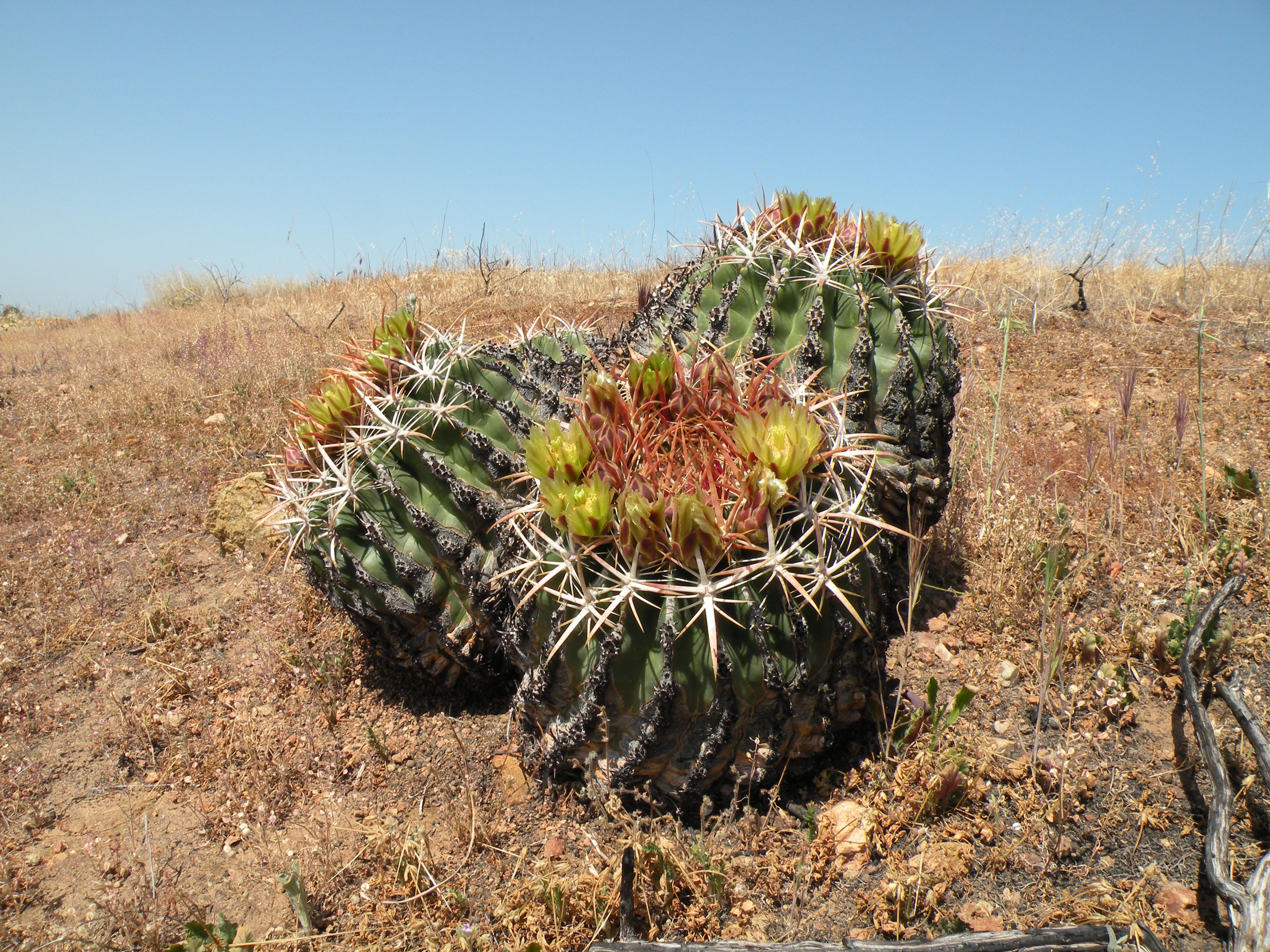
San Diego Barrel Cactus
Ferocactus viridescens
Ferocactus viridescens
Photo Credit: USFWS: John Martin
| Historically present | |
| Between 2000 and | |
| Last 10 years |
Goal: Maintain, enhance and restore coastal sage scrub on Conserved Lands in the MSPA that supports or has the potential to support VF species (i.e., cliff spurge, Palmer's goldenbush, San Diego barrel cactus, snake cholla, Blaineville's horned lizard, California gnatcatcher, San Diego black-tailed jackrabbit) and to incidentally benefit a diverse array of other species (e.g., San Diego thornmint, willowy monardella, Hermes copper, Quino checkerspot, coastal cactus wren) so that the vegetation community has high ecological integrity, and these species are resilient to environmental stochasticity, catastrophic disturbances and threats, such as very large wildfires, invasive plants and prolonged drought, and will be likely to persist over the long term (>100 years).
Management units: 1, 2, 3, 4, 5, 6, 7
In 2021, inspect occurrences of coastal sage scrub MSP VF plant species (cliff spurge, Palmer's goldenbush, San Diego barrel cactus and snake cholla) on Conserved Lands using the regional IMG monitoring protocol to record abundance and collect habitat and threat covariate data to determine management needs.
| Action | Statement | Action status | Projects |
|---|---|---|---|
| IMP-1 | Based upon occurrence status and threats, determine management needs including whether routine management or more intensive management is warranted. | On hold | |
| IMP-2 | Submit project metadata, monitoring datasets and management recommendations to the MSP Web Portal. | On hold |
| Criteria | Deadline year |
|---|---|
| Surveys Completed 2021 with Management Recommendations | 2021 |
| Threat Name | Threat Code |
|---|---|
| Altered fire regime | ALTFIR |
| Human uses of the Preserves | HUMUSE |
| Invasive plants | INVPLA |
| Urban development | URBDEV |
| File name | Lead Author | Year | Type |
|---|---|---|---|
| 2010-11 Baseline Survey Report for the Jamul Mountains Parcels of the the Otay Ranch Preserve | O'Meara, Cailin; Sundberg, J.R.; Dodero, Mark | 2011 | report |
| 2010-11 Baseline Survey Report for the Northern San Ysidro, McMillin, and Little Cedar Canyon Parcels of the the Otay Ranch Preserve | O'Meara, Cailin; Sundberg, J.R.; Bennett, Anna; Dodero, Mark | 2012 | report |
| County of San Diego MSCP Monitoring Summary Report January 1998 - June 2007 | County of San Diego | 2007 | report |
| DRAFT EXISTING CONDITIONS REPORT for the OTAY RANCH PRESERVE | 2009 | report | |
| FINAL HABITAT MANAGEMENT PLAN for Starwood - Santa Fe Valley SECOND AMENDMENT | 2000 | report |
Coastal San Diego County [1] and Baja California, Mexico [2].
Twenty-five occurrences on Conserved Lands in MUs 1 (Tijuana River Valley Regional Park), 2 (El Dorado Hills, Florida Canyon, Kate Sessions Park, Mission Trails Regional Park), 3 (East Otay Mesa, Marron Valley Mitigation Bank, Otay Mountain Ecological Reserve, Otay Mountain Wilderness Area, Otay Ranch Preserve, Rancho Jamul Ecological Reserve, San Diego National Wildlife Refuge, Sweetwater Reservoir Open Space), 4 (Mission Trails Regional Park, South Poway Cornerstone, Sycamore Canyon), 6 (Black Mountain Open Space Park, Los Penasquitos Canyon Preserve, Lusardi Creek Preserve, Santa Fe Valley Open Space Preserve, Torrey Pines State Natural Reserve), and 7 (Torrey Pines Glider Port).
None [2].
Chaparral, coastal scrub, valley and foothill grasslands, and vernal pools [1]. Sandy or gravelly soils of hillsides of chaparral [2]. Elevation range 3-450 meters [1]. Sensitive to freezing [3].
Cactaceae family [2]. Synonym: Echinocactus viridescens.
Perennial stem succulent [1]. Ant-plant protection mutualism [4].
Bloom period May-June [1].
Pollinated mainly by bees: cactus bees (Diadasia spp.), honey bees (Apis mellifera), and small native bees [4].
Urbanization has fragmented and extirpated the species from some locations [2]. Additional threats from vehicles, horticultural collecting, agriculture, non-native plants, and Argentine ants [2, 4].
Floral visitation by invasive Argentine ant (Linepithema humile) reduces pollinator visitation and seed set [4].
[1] Â CNPS, Rare Plant Program. 2016. Inventory of Rare and Endangered Plants (online edition, v8-02). California Native Plant Society, Sacramento, CA. http://www.rareplants.cnps.org, accessed 02 September 2016.
[2] Porter, J.M. 2013. Ferocactus viridescens. The IUCN Red List of Threatened Species 2013: e.T151890A572965. http://dx.doi.org/10.2305/IUCN.UK.2013-1.RLTS.T151890A572965.en.Downloaded on 02 September 2016.
[3] Loik, M. E, and P. S. Nobel. 1993. “Exogenous Abscisic Acid Mimics Cold Acclimation for Cacti Differing in Freezing Tolerance.†Plant Physiology 103 (3): 871–76.
[4] LeVan, K. E., J. H. Keng-Lou, K. R. McCann, J. T. Ludka, and D. A. Holway. 2014. “Floral Visitation by the Argentine Ant Reduces Pollinator Visitation and Seed Set in the Coast Barrel Cactus, Ferocactus Viridescens.†Oecologia 174 (1): 163–71. doi:10.1007/s00442-013-2739-z.